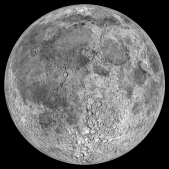

For a more detailed discussion covering observational considerations following this introduction see Page 2.
 |
A simulated projection of Moon's appearance during month of March 2004,
to demonstrate the effect of libration, created with the help of the VMA. |
As anyone who looks at the Moon from time to time will have noticed, the pattern of dark markings on its surface always looks much the same. This is despite the fact that it is revolving around the Earth. The reason is that it rotates on its axis in the same time that it takes to revolve around the Earth. (The rotation is said to be locked). If the Moon's axis was perpendicular to its orbit and the orbit was circular, then the Moon would present exactly the same face to the earth at all times. However neither of these things is true and the Moon appears to wobble and more than 50% of the surface can be seen from Earth. There are three major reasons for this wobble.
The Moon's axis of rotation is inclined at about 6.5° to the plane of its orbit. The result is that, as it revolves around the Earth, first the north pole is tilted towards us, then the south pole, so we can see just past each pole at one time or the other. This is called Latitudinal Libration and amounts to about 6½°.
The moon's orbit is not circular but elliptical, so its distance from the earth varies. When it is at its nearest (perigee) it moves more quickly in its orbit than it does when it is at its furthest (apogee). But it rotates on its axis at a constant speed, so when at apogee the rotation moves ahead of that required to keep the same face to the Earth; when at perigee the rotation lags a little behind. This results in our seeing a little beyond the eastern and western limbs. This is called Longitudinal Libration and amounts to about 7¾°.
The Earth is not small and it not at an infinite distance from the Moon. So an observer on one side of the Earth, where the Moon is rising, will see a slightly different view to someone on the other side of the Earth, where the Moon is setting. Since a single observer will be carried from one point to the other by the rotating Earth, this effect is known as the Diurnal Libration. A similar effect would occur for observers at the Earth's poles. The effect accounts for about 1°.
There is a further very small libration. The mass of the Moon is not centred at the centre of the Moon. There is slightly more mass on the Earth-facing diameter of the Moon than there is on the other two principal diameters. It is this asymmetry that resulted in the locked rotation in the first place. However, the longitudinal libration results in this axis not pointing directly at the Earth all the time, and the Earth's gravitational pull causes a very small physical wobbling of the Moon. This effect is minute (a few hundredths of a minute of arc).
The overall effect of these librations results in about 57% of the Moon's surface being visible to observers on the Earth. I know of two beautiful illustrations of this effect on the web. The first was by António Cidadão who managed to image the Moon on each day of a full lunar cycle, so his animation also shows the waxing and waning of the Moon. The second is by Laurent Laveder, PhotoAstronomique.net (look below the still pictures to find links to the animations - there are four to choose from). He managed to take a picture of the full Moon every month for a year and his animation demonstrates nicely the changing apparent size of the Moon as it moves in its elliptical orbit around the Earth. I think both these animations are remarkable. In my location, I cannot conceive of ever having either 28 consecutive clear nights, or the ability to image 12 consecutive full Moons.
Libration is represented by the lunar latitude and longitude of the central point of the disc visible to the observer. Latitude is positive north of the equator and negative to the south; longitude is positive to the east and negative to the west. Thus if the libration is positive in latitude, the north pole is tilted towards us. If the libration is positive in longitude, the eastern side is tilted towards us so Mare Smythii, for example, comes more into view.
On Page 2 I discuss how these effects combine to determine which zones become visible and therefore available for observation.
Home Back to Moon